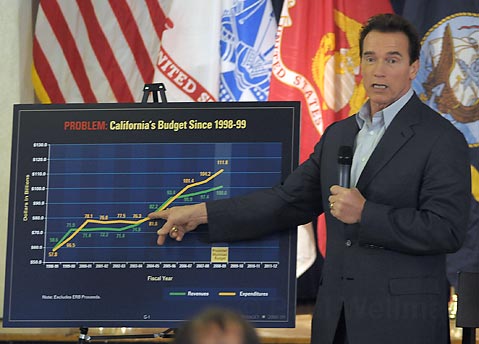State Budget Passed and Signed, County Assesses Impact
Better 85 Days Late Than Never

Governor Arnold Schwarzenegger was 85 days late in signing the budget, which meant 85 days of no reimbursements to Santa Barbara County and plenty of worry in county departments, some of which had to dip into reserves.
The $103.4 billion general-fund spending plan ends California’s longest-ever delay. Officials immediately got busy trying to determine just how the state’s budget will impact county services.
The state made up its $15.2 billion deficit- including approximately $4 billion as a result of the foreclosure crisis-through program reductions, revenue acceleration, and the elimination of cost-of-living increases. But perhaps even more daunting is the governor’s authority, conferred by this budget, to curtail midyear spending if revenue is below expectations. That means more cuts to programs and staff could come this winter, even as agencies throughout the county prepare for an even more woeful budget for the 2009-2010 fiscal year. “It is likely that another protracted budget stalemate is in store for us again,” Eric Smith, deputy superintendent of business for the Santa Barbara School District, said in an email.
The county had been developing scenarios based on what officials were hearing about the budget negotiations. On the morning of Tuesday, September 23, in anticipation of the signing later that day, assistant county chief Terri Maus-Nisich sat before the Board of Supervisors to explain where the county sat financially.
The county will lose $50,000 of Williamson Act money but receive $1.3 million in reimbursement for the cost of conducting the February 5 primary election. It appears that money to reinforce waterway levies will come to the Central Coast, while transportation project monies from Propositions 1B and 42 are also maintained.
Human and social services remain “a concern,” Maus-Nisich said, citing day-to-day costs of doing business, like renting office space, buying office supplies, and paying salaries and benefits. The county will not be reimbursed for those costs. “We have no place else to go,” said Kathy Gallagher, director of the Department of Social Services. “It will directly impact staffing,” she said, which in turn will impact clients. A county letter to SEIU Local 721, which represents more than 500 county employees, indicated that 39 social service positions would be cut. Earlier this year, county departments made $15 million in cuts.
The budget could also bode trouble down the road for the Sheriff’s Department’s efforts to build a new jail in North County. The budget included the funds that the Sheriff has been hoping for but didn’t include a “trailer bill” authorizing the Department of Corrections (CDCR) to access the funds. Maus-Nisich indicated the Legislature may take the issue up in December and that the situation should be clear by the time the financing is actually needed. “No one is losing faith,” said Seth Unger, a CDCR spokesman. “But it was disappointing that it wasn’t able to be included.”
While the state budget restores almost $100 million to the University of California that the governor had earlier targeted for cuts, the UC system will still have to cut spending by $100 million because of inflation and costs associated with student enrollment growth. Office positions and administrative spending in the system, which has more than 220,000 students in the 10 schools, have already seen more than $20 million in cuts. Included in the $3.3 billion UC operating budget is additional funding for several facilities projects, including an arts building at UCSB.
Santa Barbara School District’s Eric Smith said the state provided a small revenue increase compared to what the district projected this summer when it made roughly $4 million in cuts. “In addition to the restoration of cuts made to several categorical programs, the state’s budget provides the districts with a very small (0.68 percent) cost-of-living adjustment to its revenue limit, the source of funding for most of the district’s general-purpose expenditures,” he wrote.



